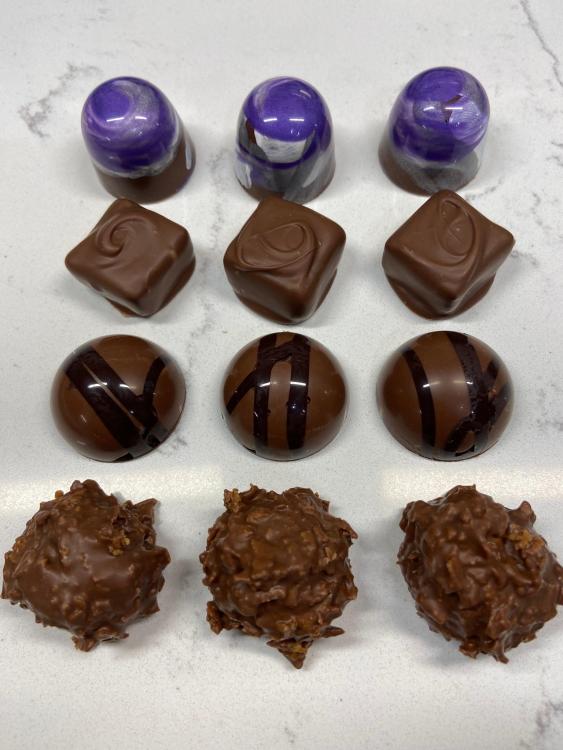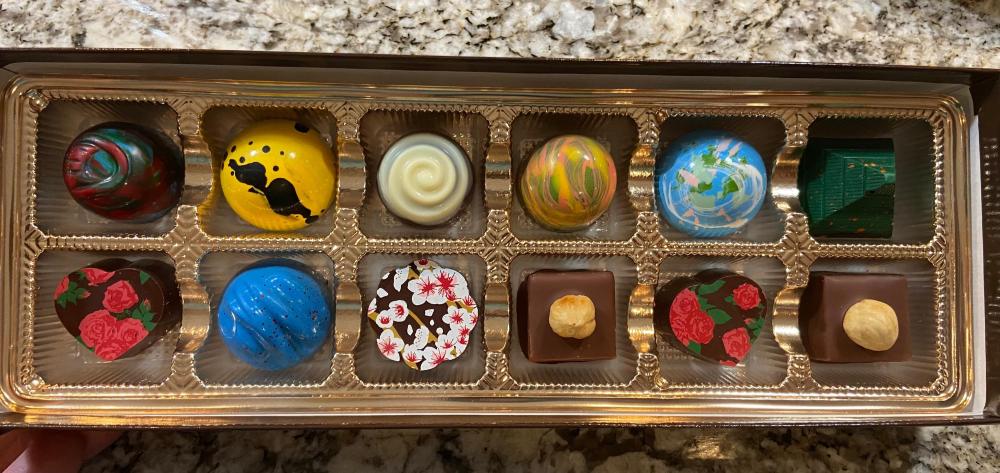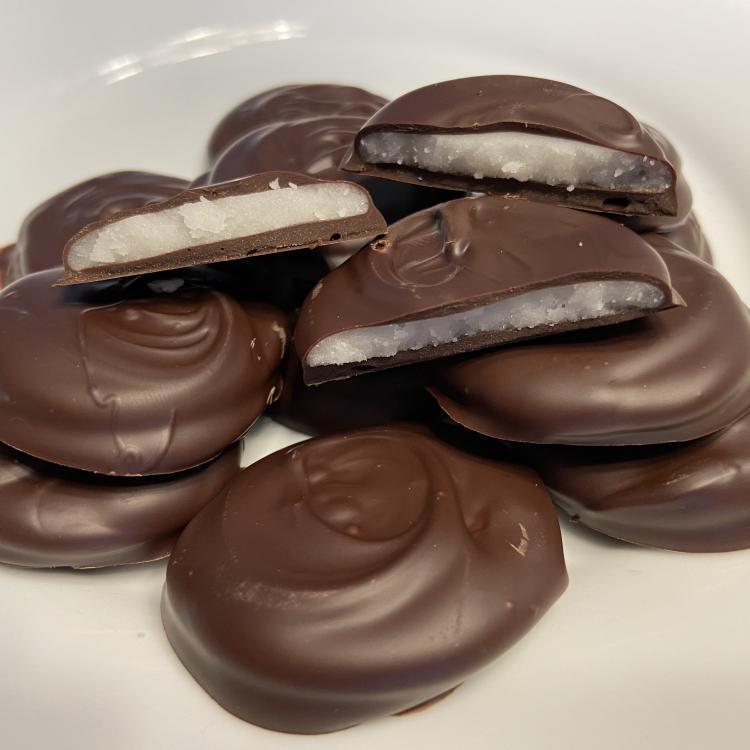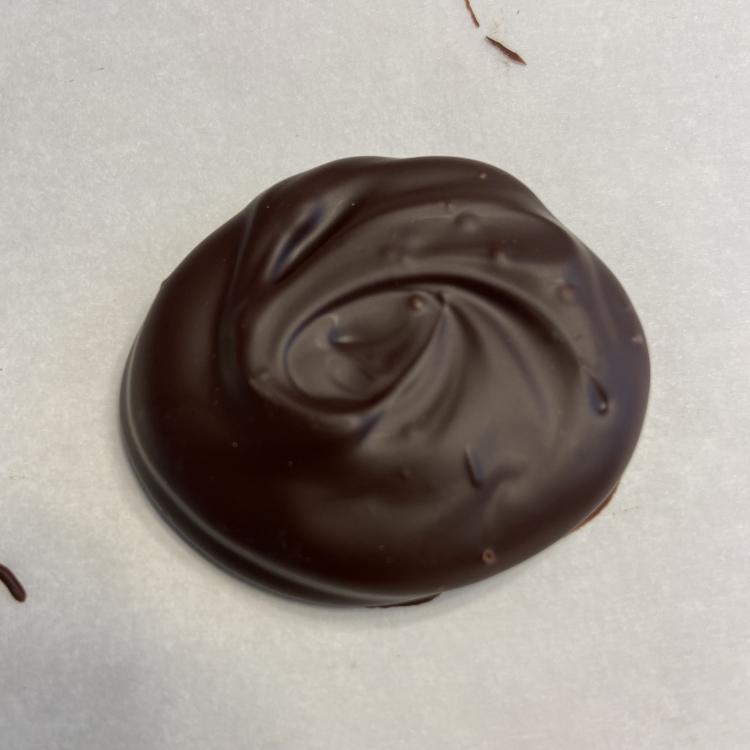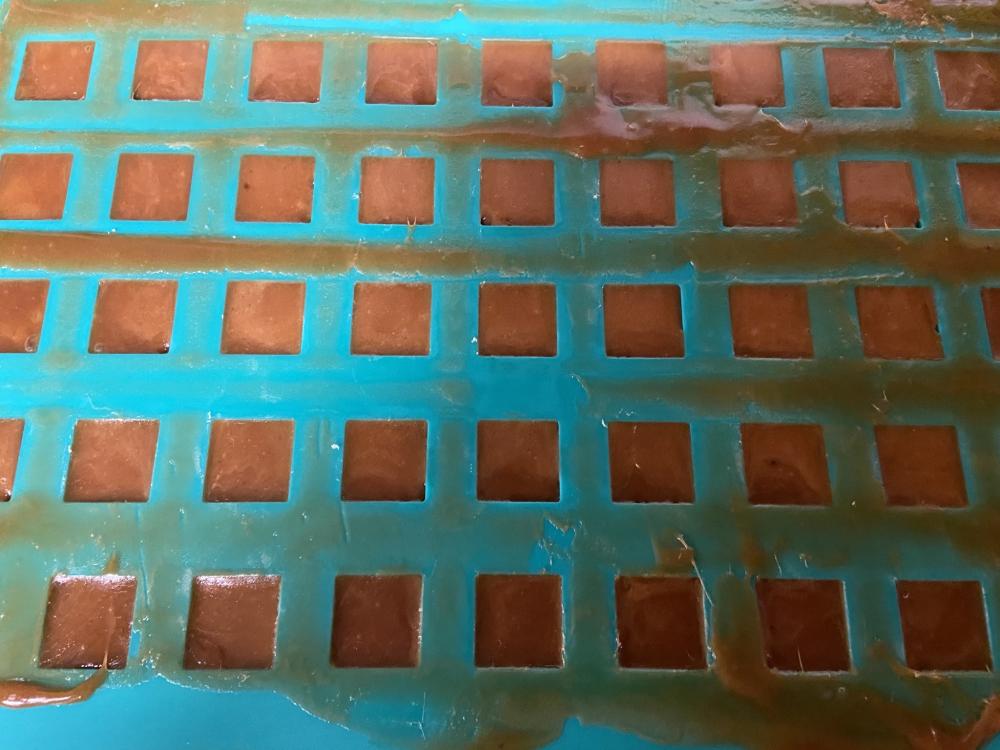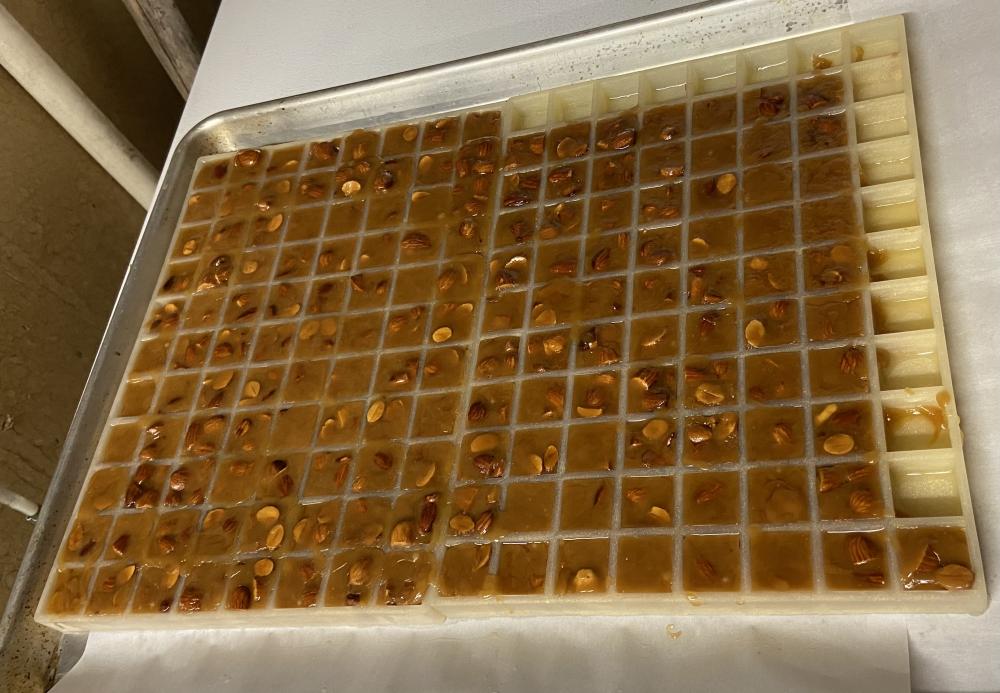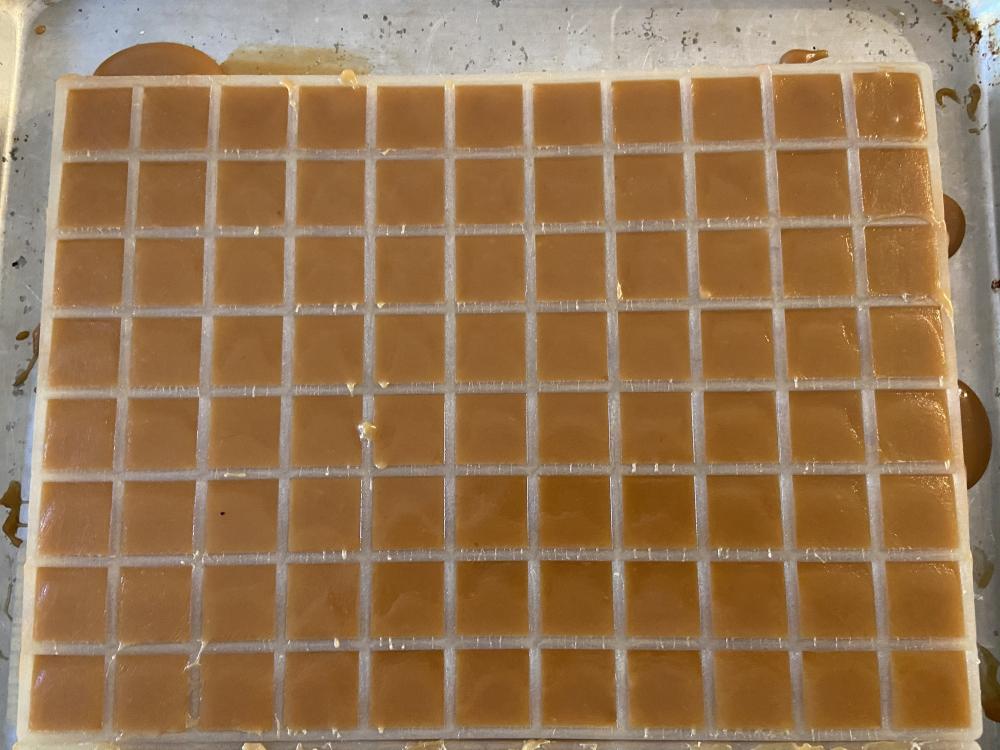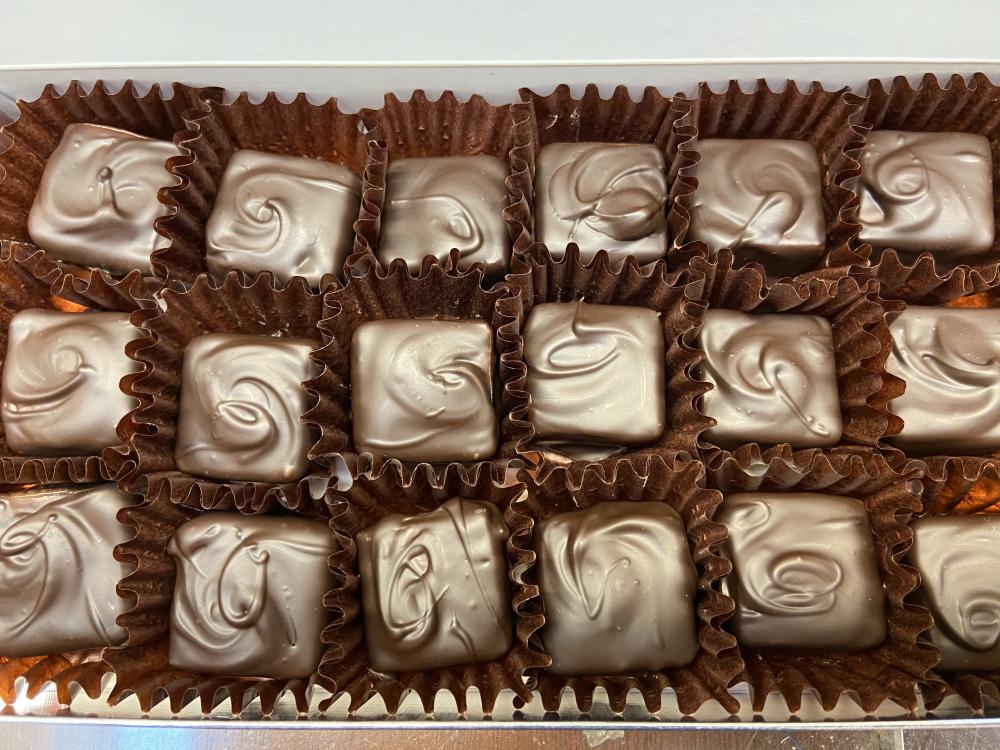-
Posts
204 -
Joined
Content Type
Profiles
Forums
Store
Help Articles
Everything posted by GRiker
-
I’ve been considering getting a guitar cutter for ganaches. I found this one on Etsy from someone in Ukraine selling confectionery tools. It’s a good price when compared to the Dedy and customers seem happy even though ship time is long. For those of you who have a guitar cutter, how does this seem to compare to what you have? https://www.etsy.com/shop/IMOSUA?ref=related&from_page=listing&listing_id=1173031323#items
-
When talking about the temperature element of tempering chocolate Greweling mentions that after the chocolate is heated to above the temperature where all crystals are melted out, it's the "reality of tempering" (as I understand it the need to use the chocolate in the near future) that "in order to form crystals relatively quickly, the chocolate is usually cooled to well below 32C/90F during seeding." This lowering of temperature speeds up the formation of all crystals, then raising the temperature back to 32C/90F ensures that only the type V crystals remain, and more of them because the chocolate was cooled down. He seems to suggest that while it's not practical to go from all crystals melted out chocolate (or cocoa butter) directly to chocolate in temper at 32C/90F, it is time that is the limiter, not that the crystals won't ever form. Perhaps the residence time or the time that cocoa butter spends at the proper temperature for crystal formation during tempering is much shorter going from solid room temp. to being held 33.1C than the time to for those same crystals to form when going from liquid cocoa butter to held at 33.1C? @Kerry BealIt sounds like you're saying that coming down from liquid that the crystals will never form if held at 33.1C. but maybe it's just impractical because they'll take too long to form?
-
@Kerry Beal What would happen if you put fully melted 60C cocoa butter in the eztemper set at 33.1C? Wouldn’t the type V crystals form at that temperature?
-
@Haley What kind of wine fridge are you using? Does it specifically have humidity control as a feature?
-
Made some new recipes for a fundraising auction last week. Really happy with how they turned out. Purple Dome: Pecan Caramel Popcorn (Maple Pecan Praline (Notter) w/ a commercially prepared piece of caramel popcorn in side.) Just thought it would be fun to try. It took some time to find small fully covered pieces of popcorn to fit in the mold, but it worked. Square - Chocolate Caramel (Greweling.) Dark Stripes - Sesame Ginger (Greweling at home, recipe modified from truffle to molded chocolate). This is the first time I've made a more savory filling. I only used half the ginger because I thought it would be too strong. While it was the first day it mellowed considerably by day two. Would use the full amount next time. I used the mini massage gun from this discussion to help tap out the bubbles, but should have used it more because the milk chocolate didn't settle all the way in. Another issue is that some of the dark stripes came out of temper Balls - Hazelnut Truffles (Greweling at home, added crushed croquantine to the outside.) Also the first time I've made anything with praline paste. I got some because I see it talked about here a lot and wanted to try it. Then when I got it, I wasn't quite sure what to do with it. Finally settled on these truffles. Adding the croqantine on the outside created some fun texture.
-
I also purchased the FitRX Mini Massage gun. I don't live near a Big5, but found it at Walmart for delivery . Used it this past week and loved it. Like Kerry said, it's so much quieter and works well. I used it for molded chocolates, hemispheres and domes. Also appreciated using it after capping the molds. Not only does it get the bubbles out, but it smooths the bottoms at the same time. Thanks @Kerry Beal for the idea!
-
Do you worry about the humidity since the wine cooler isn't humidity controlled?
-
How do you use your wine/chocolate cooler?
-
I have also made the chocolate version. Love them!
-
Adding my 2 cents on crystalizing caramels. For a few years I've been using Grewlings Chocolate and Confections at Home caramels recipe with sweetened condensed milk. Love the flavor but they would only go a max of a few weeks before they would start to crystallize. Also have Grewlings Chocolate and Confections (not at home version) that has three different caramels recipes, with evaporated milk, sweetened condensed milk and fresh dairy milk. I purchased some glucose to use in place of corn syrup that I've used before. I tried both the evap. milk and sweetened condensed milk versions. I dipped them in milk chocolate then kept a few stored away to check over time. At three and four weeks the evap. milk ones looked fine, while the sweetened condensed milk version had begun to crystallize by week 3. Now at 2 months out the sweetened condensed version is completely crystallized and the evap. milk version is starting to crystallize. Not sure why this is so. But while I prefer the flavor of the sweetened condensed milk version, planning on making the evap. milk version my go to. (maybe I'll try the fresh dairy milk version sometime.)
-
I'm afraid I don't have a solution, but have experienced a similar issue. I have used a couple different milk chocolate 10-pound blocks from Guittard. I put chunks in the melter at a higher temperature the night before I want to use them. In the morning the block is completely melted except for little particles that don't want to melt. I've used the same method as you of beating it into submission using my immersion blender - a pain. This only happens with one type of the two blocks that I've used. Interestingly, these particles only appeared when melting the from the factory block. After I blend it and melt it all out, putting the unused tempered chocolate away, I don't have the same issue again when I remelt. At first I thought it was because I wasn't heating the chocolate to a high enough temperature, but my thermometer told me that couldn't really be the case. Since it only happens with new chocolate I suspect my culprit was type VI crystals. With your chocolate only sitting a short time before the remelt, it certainly can't be type VI crystals. Wish I could help!
-
@Jim D. I would have loved to connect but long story short we were on a very tight timeline to get from Austin to DC and connect with family before they were flying out of DC. We ended up with just over an hour to visit. I knew if I connected that we would miss them all together. I got some push back about even running into town! We might be headed back that direction in a week or so and I’ll reach out if we do. Definitely can see why you don’t make that chocolate chip cookie everyday. We agreed that these are not really for eating but that each one is a tasting experience.
-
In a hurried drive from Texas to DC, found myself driving along Route 81 and had to run by Cranberry's to pick up some of Jim's chocolates. With seven in our group, my only regret is that I didn't buy more than 2 boxes. We're trying to savor them and not eat them all at once! The assortment we got has some of these same pieces. The dark caramel shards and vanilla buttercream - creme brûlée (what's the difference between vanilla buttercream and vanilla ganache?) were delicious. The raspberry ganache with rosewater had an intense raspberry paired nicely with the dark chocolate, and the chocolate chip cookie was aptly named (what filling did you use with the pecans, chocolate chunks and shortbread bits? It didn't have any air bubbles in it and I wondered how you got it all in there so nicely). We also really liked the texture of the crispy hazelnut ganache. I'm happy to report that Jim's chocolates are very nice to eat in addition to being nice to look at!
-
@pastrygirlGood to see how it fits. I’ll see what I can find. Thanks.
-
I've wanted to make peppermint patties for a while but was intimidated since I'd never made fondant before. I'd been looking online for non-fondant based recipes but knew they weren't quite what I was looking for when they dipped their frozen patties into melted chocolate chips! I'm so glad to be able to read old threads. Thank you @Chocolot and @Kerry Beal for the recommendation for Greweling. This week I finally decided to give it a go. I used Grewelings recipe subbing peppermint oil for the fresh mint and omitting the invertase as I don't have any on hand. The whole process was very satisfying and delicious. I don't have a fondant funnel, so I just used a 1/2 T measure. That worked but I had very different sized circles. I'd like to figure out how to make a more uniform circle without acquiring another piece of equipment. Any suggestions? I dipped them in Guittard Onyx 72% which complimented the mint nicely. One of my sons called them "crispy". They are more like a traditional York patty. I am going to get some invertase to try for another option. I'm not too patient, so I'm sure I'll opt for more invertase over less so as to not have to wait so long.
-
@pastrygirlThank you for the insight. I will make my way to a restaurant supply house with my melter and see if the corner radius fits. Thanks again.
-
I'm looking for a second pan for my newly acquired melter. tcfsales.com lists the Pan Dimensions: 325 x 265 x 100 mm. A 1/2 size restaurant pan is 325 x 265 and I can get a 4 inch or ~100mm deep. Any reason I shouldn't buy a restaurant pan for $10 instead of the extra pan listed for $55?
-
Just reading up on the tips and tricks here getting ready to play with my newly acquired 6 kg Mol d'art melter I got on eBay. Looks like the seller has another one to sell as well (click this link to see the listing). The one I got was a little dirty and has a little wear on the cord, but looks in good condition overall. I haven't used it yet, but wanted to post this second melter from eBay since I've been watching for one for a while and they don't come along very often. Bidding ends Wednesday, 7/7/2021
-
They are item number 606015 https://shop.chefrubber.com/item/606015/Candy-Mould-Square/
-
Looks like you’re in the Washington Post this morning, Congratulations! 🎊 https://www.google.com/amp/s/www.washingtonpost.com/food/2021/01/31/chocolates-valentines-day/%3foutputType=amp
-
I’ve used the Chef Rubber molds several times now. They are twice as expensive as the O’Creme molds but soooo much easier to use. Worth it! I bought two of them. One batch of caramel fills about 1 2/3 of the mold. Once I’ve finished cooking the caramel in my Presto pot, I strategically pour the caramel into the molds then quickly scrape the top with my taping knife. It’s super easy and very minimal waste. I had no problems getting the caramel out of the mold. It was so successful I decided to try my almond toffee. I had to cut the almonds in half widthwise so they’d easily fit in the mold, but this also worked out great. The only downside was that I always have a bit of butter that separates out at the end and it’s difficult to wipe out the little bits of butter which then get in my chocolate when I dip them. Still figuring out what to do about that. Overall, I’m very pleased. The uniform size is great and it makes a lovely box! Here’s the O’Creme mold for reference: Not sure what I’m going to do with it now but if anyone can think of a good use for it, it’s yours for the cost of shipping!
-
Thanks for this recipe. I made them with dark brown sugar as I didn’t have muscavdo. I made my own oat flour in my food processor from rolled oats. I’m a huge chocolate chip fan but kept to the fewer chips as called out in the recipe. I found they had a nice texture and weren’t too sweet.
-

Molded and Filled Chocolates: Troubleshooting and Techniques
GRiker replied to a topic in Pastry & Baking
@curlsThanks! That’s some pretty skilled work. Sometime I’ll have to try it just for fun and hope most of it makes it back in the bowl. -

Molded and Filled Chocolates: Troubleshooting and Techniques
GRiker replied to a topic in Pastry & Baking
I’ve always wondered...how do you manage to get a puddle of chocolate back into the bowl? I have a plastic chocolate scraper. Is that what you use? -
Thanks Robert for this suggestion. I have used it a couple times now. I love how little of my attention it requires!


